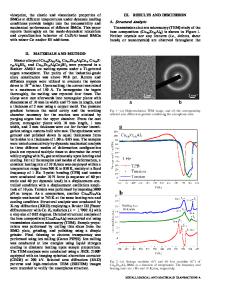Effect of Loading Rate on Failure in Bulk Metallic Glasses
- PDF / 766,450 Bytes
- 6 Pages / 612 x 792 pts (letter) Page_size
- 36 Downloads / 366 Views
CC6.2.1
Effect of Loading Rate on Failure in Bulk Metallic Glasses T. Jiao,1 C. Fan,2 L.J. Kecskes,3 T.C. Hufnagel,2 K.T. Ramesh1 1
Department of Mechanical Engineering, Department of Materials Science & Engineering, The Johns Hopkins University, Baltimore, MD 21218, USA 3 U.S. Army Research Laboratory, Aberdeen Proving Ground, MD 21005-5069, USA 2
Abstract We have investigated failure in bulk metallic glass-forming alloys under dynamic compression. We implemented a recovery technique for the compression Kolsky bar to obtain dynamically deformed, intact specimens at various stages of deformation; this allows us to characterize the development of failure. We have also used high-speed photography to examine the failure process during the recovery experiments. The experimental results indicate that the failure under dynamic loading is somewhat different from that under quasi-static loading. Specimens subjected to quasistatic deformation developed multiple shear bands and substantial plastic deformations, while specimens subjected to dynamic (strain rate ~103 s-1) compressive loading fail by fracture along one dominant shear band. The mechanisms of dynamic failure in bulk metallic glasses are discussed on the basis of these experimental results. Introduction When loaded under uniaxial compression 1-3, most monolithic metallic glasses show little plastic deformation to failure (0-4%plastic strain). Most of this prior work has focused on quasi-static deformation. The dynamic behavior of bulk metallic glass, however is very important for some applications. Bruck et al.4and Subash et al.5have examined the behavior of amorphous Zr41.25Ni10Cu12.5Ti13.75Be22.5 under dynamic compression. Their results show that, for strain rates of about 103s-1, metallic glasses exhibit little plastic deformation. Previously, we have tested the non-beryllium amorphous alloy of Zr57Ti5Cu20Ni8Al10 (Reference 6). We found that the failure strength decreases with increasing strain rate. The mechanical behavior is determined by the operative failure mechanism. In this work, we examine the dynamic behavior of amorphous Zr57Ti5Cu20Ni8Al10 using a Kolsky bar technique modified to permit examination of the samples after deformation. We compare the failure of the dynamically deformed specimens with that of those deformed under quasi-static loading. Experimental Technique Samples of Zr57Ti5Cu20Ni7Al10 were melted under an argon atmosphere and cast into 3mm diameter rods. We used electronic discharge machining (EDM) to cut 1.8 mm long specimens for testing under quasi-static and dynamic loading. The ends of the specimens were lapped to remove the portion affected by EDM, and to ensure parallelism of the ends to each other and orthogonality to the loading axis.
CC6.2.2
The quasi-static tests were done using an MTS servo-hydraulic testing machine (MTS Systems Corp., Eden Prairie, MN) operated under displacement control with compression platens and a strain rate of ~ 1×10-4s-1. ASTM standard (E9-89 (1995)) for quasi-static testing recommends an aspect
Data Loading...











